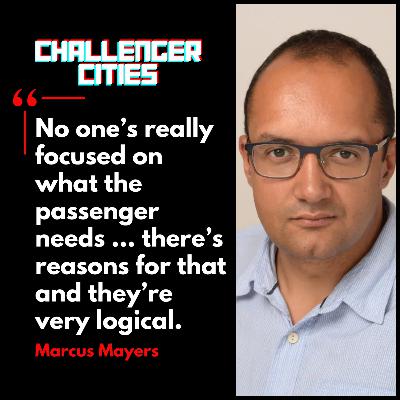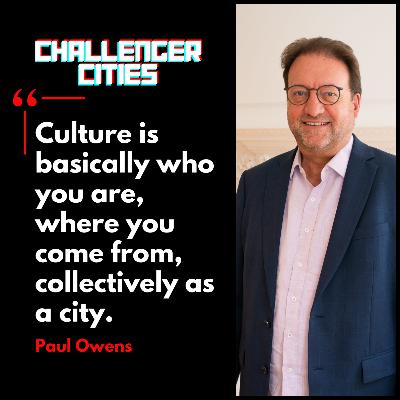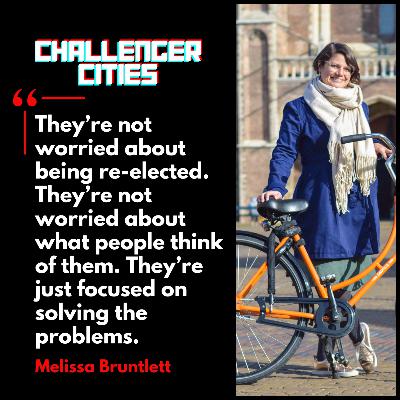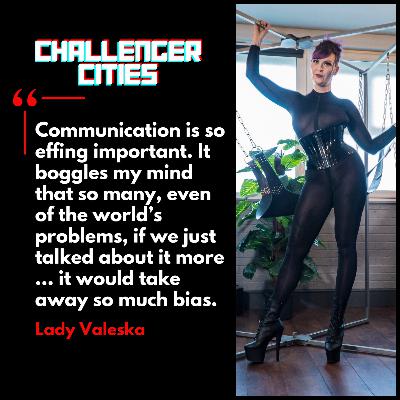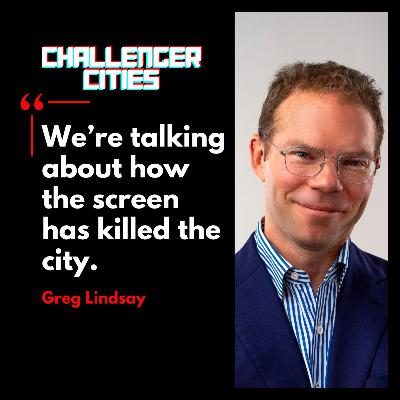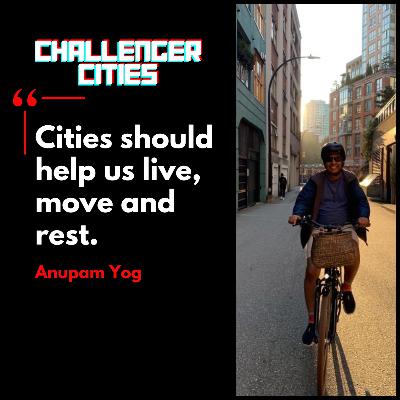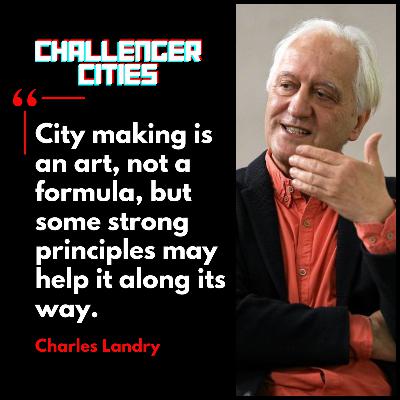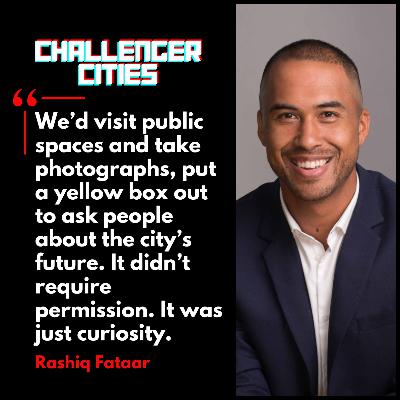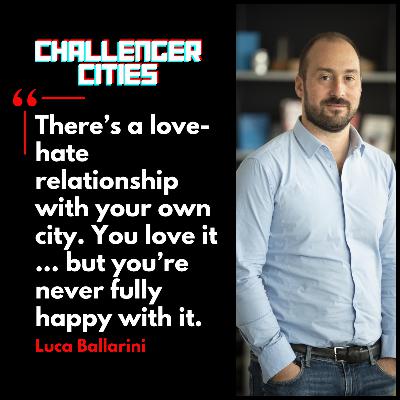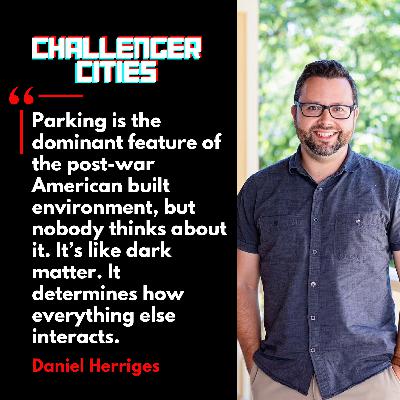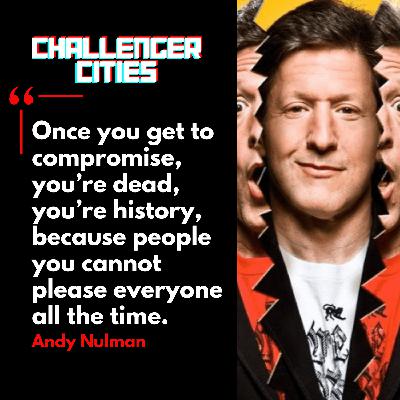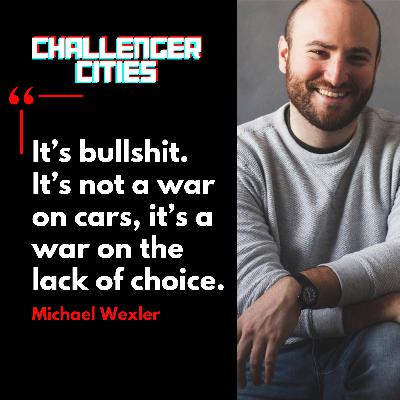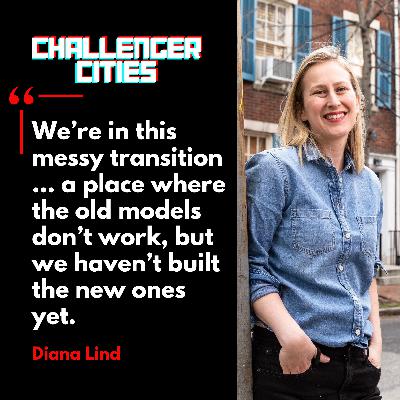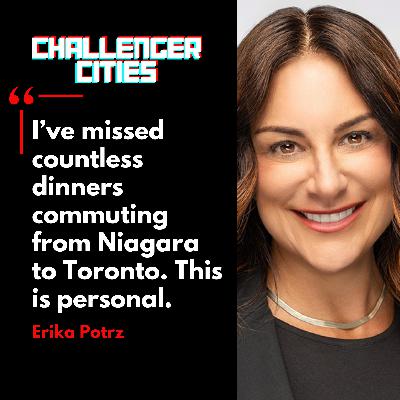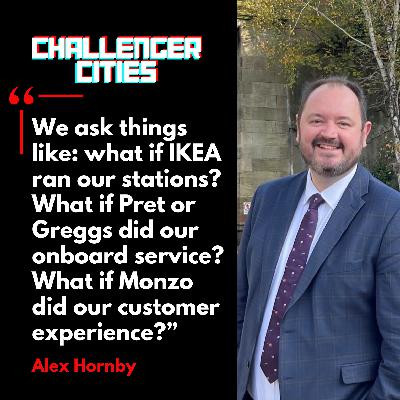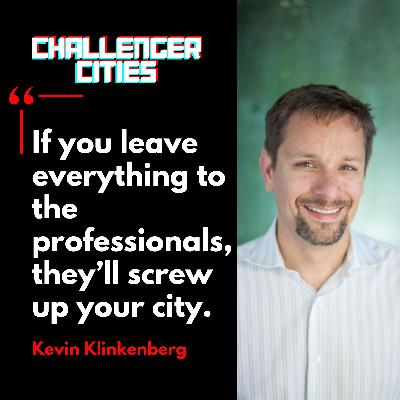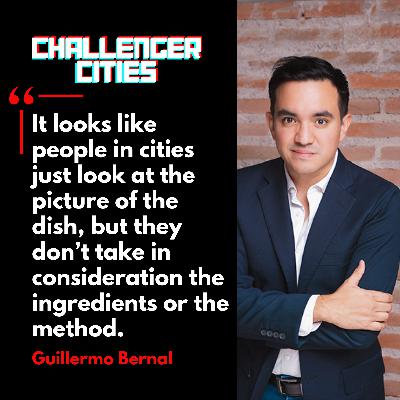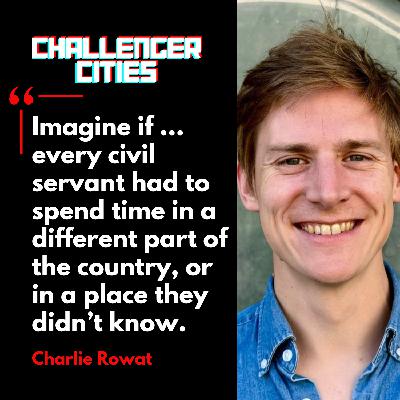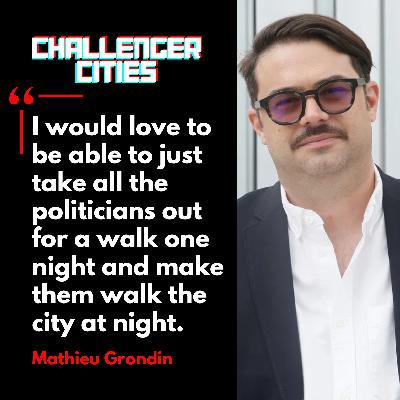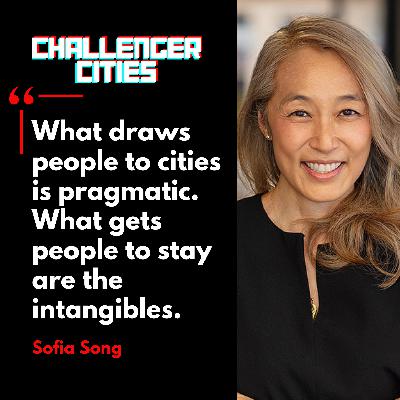Discover Challenger Cities
Challenger Cities

Challenger Cities
Author: Iain Montgomery
Subscribed: 4Played: 66Subscribe
Share
© Challenger Cities 2024
Description
Iain Montgomery of Now or Never Ventures interviews urbanists, creatives, transit and development types to explore how cities can punch above their weight and create distinctive new futures outside of the tired playbooks.
55 Episodes
Reverse
Iain Montgomery and Marcus Mayers discuss the complexities of transport systems, focusing on the balance between passenger experience and operational efficiency. They explore the impact of government regulations, the role of technology, and the need for a mindset shift in transport management. The discussion emphasises the importance of understanding passenger needs, improving accessibility and rethinking marketing strategies in the transport sector. The conversations leads to a call for a more human-centred approach to transport innovation that prioritises quality of life and effective communication.TakeawaysPassenger experience is often overlooked in transport operations.Operational efficiency is prioritized over passenger needs.Government regulations can complicate transport management.Technology can enhance the passenger experience.Quality of life should be a key focus in transport planning.Transport systems need to adapt to changing commuting patterns post-COVID.Accessibility is crucial for improving public transport usage.Marketing strategies in transport should focus on consumer needs.Innovative solutions are needed for better station navigation.Cultural challenges within transport organisations hinder progress.Chapters00:00 Introduction to Railway Innovation and Urbanism03:39 Passenger Needs vs. Operational Efficiency06:31 The Impact of Government Decisions on Train Operations09:12 Reforming Transportation Governance12:01 The Role of Digital Infrastructure in Transportation14:28 Quality of Life and Transportation Efficiency17:16 Addressing Anxiety in Public Transport20:03 The Future of Public Transport Management25:18 The Disconnect Between Governance and Transport27:14 Consumer-Centric Marketing in Transport29:37 Navigating Station Environments: The User Experience31:37 Innovative Signage Solutions for Accessibility36:27 The Impact of Historical Design on Modern Transport40:45 Rethinking Transport: A Customer-Centric Approach44:31 The Need for Bureaucratic Reform in Transport
In this episode of Challenger Cities, we chat with Paul Owens, co-founder of BOP Consulting, long-time collaborator of Charles Landry, and one of the most quietly influential thinkers on culture and cities anywhere in the world.Paul has spent decades helping cities understand something most of them overlook: culture isn’t a sector or an industry, it’s an operating system of a place. It’s who you are, where you come from, and how you imagine yourself collectively as a city.We talk about:Culture as a public good, drawing on Robert Hewison’s definition and why it still cuts through the noise.Why assets don’t matter nearly as much as institutional capacity — the ability of a city to reflect on itself and act with confidence.London 2012 and how the Cultural Olympiad temporarily galvanised the UK’s cultural brain.Berlin’s cultural immune system, its resistance to monoculture, and why it remains a beacon of civic confidence.Chengdu’s “Park City” model, greenways, bike networks and how spatial planning can actively cultivate cultural life.The vanishing of cheap space and the consequences for artists, identity and civic vibrancy.Participation as democratic infrastructure, and why cultural engagement is one of the few things that strengthens both social cohesion and civic imagination.Paul’s magic wand: a permanent cultural endowment that recycles the public value culture creates back into the ecosystem.This episode is for anyone who senses that culture is doing far more work in a city than we usually acknowledge. Paul offers a way to see it, and measure it, and invest in it, that feels both urgent and hopeful.
Melissa Bruntlett discusses her book 'Women Changing Cities' and the transformative role of women in urban mobility and planning. She emphasizes the importance of empathy, care, and community engagement in creating sustainable and equitable cities. The discussion covers various global cities, the challenges faced in transportation, and the impact of female leadership on urban change. Bruntlett shares insights on grassroots movements and the need for collaboration to drive positive change in urban environments.TakeawaysWomen are making significant contributions to urban mobility.Empathy and care are essential in urban planning.Cities should be designed with children and families in mind.Grassroots movements can lead to meaningful change.Female leadership often results in more inclusive policies.Transportation systems must address everyday needs, not just commutes.Collaboration and community engagement are key to success.Stories of transformation can inspire action in other cities.Urban planning should focus on creating enjoyable public spaces.Change takes time, and patience is crucial in advocacy.Chapters00:00 Introduction to Urban Mobility and Advocacy04:32 Women Transforming Cities07:06 The Inspiration Behind 'Women Changing Cities'10:09 The Role of Women in Urban Mobility12:34 Care and Mobility: A New Perspective15:14 Empathy in Urban Leadership17:57 Navigating Backlash Against Female Leaders20:25 Collective Efforts in Urban Transformation23:03 Finding Common Ground in Urban Development25:39 Global Perspectives on Urban Spaces31:18 Exploring Urban Challenges in Delhi34:04 Innovative Solutions for Women's Safety in Transportation38:46 Empowering Local Voices in Urban Change39:17 Finding Your Place in Urban Advocacy43:51 The Role of Women in Urban Leadership50:04 The Importance of Fun in Urban Spaces56:43 Exploring Urban Challenges and Innovations
This one’s a little different. We sat down with Lady Valeska, a professional dominatrix now based in London, to talk about what cities, workplaces, and leaders could learn from the world of kink.It turns out, quite a lot!We talked about power, shame, permission, and trust, but not in the ways you’d expect. Lady Valeska’s version of dominance isn’t about control, rather it's about awareness. She reads people the way good designers read context: through signals, not assumptions.We got into:How communication and consent could fix more than just our sex lives.Why shame might be the most dangerous civic material ever invented.The death of anticipation in a world addicted to instant gratification.What the kink community understands about safety that most cities don’t.And why London’s chaos has its own erotic energy — while Toronto still plays it a little too polite.It’s not an episode about sex. It’s about systems, culture and the trust it takes to make exploration feel safe.Because whether you’re designing a city, a company, or a scene ... the rules are the same: communication, consent, boundaries, safe words and aftercare.Chapters00:00 Introduction to Kink and Dominatrix Culture04:45 The Evolution of a Dominatrix07:27 Communication and Consent in Kink10:02 Creating a Safe Space for Exploration12:43 The Dynamics of Shame and Acceptance15:03 Gender Fluidity and Societal Norms17:55 Cultural Differences in Leadership and Communication20:22 The Impact of Technology on Kink and Sex Work22:42 The Diversity of Kinks and Online Perceptions25:11 The Importance of Failure in Personal Growth27:46 Communication in Kink and Relationships30:55 Cultural Perspectives on Kink and Acceptance32:02 Comparing Life in Toronto and London36:21 Generational Differences in Acceptance39:05 Wishing for a Better Future: Free Healthcare for All39:56 Exploring Taboo Conversations40:19 Personal Growth Through Challenging Topics
Iain Montgomery and Greg Lindsay explore the intersection of urbanism and technology, discussing how screens and AI are reshaping cities. They delve into the implications of surveillance, the concept of the 15-minute city, and the importance of social equity in urban planning. The discussion also touches on Estonia's digital governance model and the challenges posed by the Saudi urban experiment. Ultimately, they emphasize the need for community engagement and a reimagined approach to urban living.TakeawaysUrbanism is about creating spaces that foster community and connection.Screens and technology have significantly altered urban life and social interactions.AI and augmented reality present both opportunities and challenges for cities.Surveillance technologies can undermine the anonymity that cities provide.The 15-minute city concept aims to create accessible urban environments.Social equity must be considered in urban planning and development.Data privacy is a critical concern in the age of smart cities.Estonia serves as a model for digital governance and public service delivery.The Saudi urban experiment raises questions about the future of city planning.Community engagement is essential for successful urban development.Chapters00:00 Introduction to Urbanism and Podcasting05:34 The Impact of Screens on Urban Life08:19 Augmented Reality and AI in Urban Spaces11:07 The Role of Technology in Urbanism14:01 Urbanist Perspectives on Mobility and Transportation16:33 Cultural Contexts of Urban Living19:28 The Future of Urbanism and Family Living22:23 Challenges of Urban Development and Gentrification25:24 The American Dream and Urban Planning32:50 Technological Forces Shaping Urbanism34:44 The Role of Consultancies in Urban Development37:19 Data Collection and Urbanism Challenges40:10 Public vs. Private Sector in Digital Transformation43:48 Estonia's Digital Governance Model45:44 The Dystopian Nature of New Cities51:12 Housing Crisis: A Conspiracy of Affordability56:21 The 15-Minute City: A Controversial Concept01:00:57 The Future of Urbanism: High Touch vs. High Tech
In this conversation, Iain Montgomery and Anupam Yog delve into the concept of urban mindfulness and its implications for city design. They explore how mindfulness can enhance urban living, the importance of community engagement, and the potential of lesser-known cities like Ramsgate as models for transformation. The discussion emphasizes the need for compassion in urban planning and the idea that cities should facilitate a balance between movement and stillness. Anupam shares insights from his experiences in Singapore and other cities, advocating for a new paradigm of urban living that prioritizes well-being and connection with nature.TakeawaysMindfulness can be a transformative approach for urban living.Cities should be designed to foster community and connection.Ramsgate serves as a case study for urban transformation.The concept of 'gentle density' is crucial for sustainable cities.Urban design must prioritize mental and emotional well-being.Seaside towns have unique potential for revitalization.Compassion and patience are essential in urban planning.Next cities are often neighborhoods and towns, not just major urban centers.Cities should enable a balance of live, move, and rest.Engaging with local communities is vital for effective urban design.Chapters00:00 Introduction to Urbanism and Mindfulness07:15 The Intersection of Cities and Mindfulness11:24 Mindfulness in Urban Spaces14:27 The Importance of Slowing Down19:17 Singapore as a Model for Conscious Urbanism24:08 The Future of Urbanism: Balancing Economy and Ecology31:33 Cultural Complexity in Urban Design34:24 Mindful Choices in City Planning38:32 Engaging Communities in Urban Development43:39 The Future of Tourism and Urban Living48:39 Next Cities: Beyond the Usual Suspects56:16 Magic Wand for Urban Transformation58:09 Introduction to World City and Its Initiatives58:35 Engagement and Future Conversations
SummaryIn this conversation, Charles R. Landry discusses the concept of creative cities, emphasizing the importance of imagination, psychology, and human-centered design in urban planning. He explores how cities develop identities, the psychological complexities they face, and the impact of gentrification on urban evolution. Landry highlights the need for spaces that foster connection and the role of curiosity in understanding urban dynamics. He concludes with thoughts on the future of cities and the importance of simplifying complex ideas without losing their essence.TakeawaysThe creative city concept focuses on imagination in urban planning.Psychology plays a crucial role in how we perceive cities.Cities can have inferiority complexes affecting their identity.Gentrification can evolve neighborhoods positively or negatively.Human-centered design is essential for livable cities.Connection and interaction are vital for urban life.Curiosity drives exploration and understanding of cities.Cities should facilitate encounters between diverse groups.Urban growth presents challenges that require innovative solutions.Simplifying complex urban issues can lead to clearer priorities.Chapters00:00 Introduction to Creative Cities02:10 The Role of Psychology in Urban Planning06:22 City Stereotypes and Psychological Complexes10:33 The Dynamics of City Identity and Confidence13:07 Gentrification and Urban Evolution19:05 The Challenges of Urban Growth and Gentrification23:01 The Importance of Human-Centered Design30:01 The Future of Cities and Connection35:06 Curating Spaces for Connection41:20 The Magic Wand for Cities55:07 Closing Thoughts on Urban Innovation
In this conversation, Iain Montgomery and Rashiq Fataar delve into the complexities of urbanism in South Africa, particularly focusing on Cape Town. Rashiq shares his journey from actuarial science to becoming a self-appointed urbanist, emphasizing the need for innovative urban solutions that address social and spatial inequalities. They discuss the current state of South African cities, the lessons learned from global urbanism, and the challenges faced in urban development. Rashiq highlights the importance of public spaces, transportation, and housing, while also envisioning a future where Cape Town can thrive as a model for urban living. The conversation concludes with Rashiq's vision for transformative change in urban policy and infrastructure.TakeawaysUrbanism in South Africa is often overlooked.Rashiq Fataar transitioned from actuarial science to urbanism.Curiosity about cities can lead to impactful projects.South African cities face unique social and spatial challenges.Public spaces and access to nature are crucial for urban living.Learning from global cities can inform local practices.Transportation infrastructure is key to urban connectivity.Events like the Olympics can catalyze urban development.There is a need for radical urbanism in South Africa.Quality of life improvements must be prioritized in urban planning.Chapters00:00 Exploring Urbanism in South Africa04:56 Rashiq Fataar's Journey to Urbanism09:58 The State of South African Cities14:57 Learning from Global Urbanism19:41 Challenges and Opportunities in Urban Development24:46 The Role of Events in Urban Transformation29:16 Vision for the Future of Cape Town34:19 The Magic Wand for Urban Change
In this conversation, Iain Montgomery speaks with Luca Ballarini about Utopian Hours, a festival in Turin that celebrates urbanism and creativity. They discuss Luca's journey from architecture to graphic design, the challenges of transforming urban narratives, and the unique identity of Turin as a city. The conversation highlights the emotional connection people have with their cities and the importance of community engagement in urban development. Luca shares insights on the festival's diverse speakers and topics, as well as his vision for a more accessible and imaginative approach to urbanism.Utopian Hours is a festival celebrating urbanism and creativity.Turin is known as the city of four rivers, which shapes its identity.Luca Ballarini transitioned from architecture to graphic design and urbanism.Cities can be transformed through imagination and community engagement.There is a love-hate relationship with one's own city, driving change.Utopian Hours features diverse speakers and innovative ideas.The festival aims to inspire attendees to think differently about urban spaces.Emotional connections to cities can drive urban transformation.Luca envisions simplifying urbanism rules for experimentation.The festival fosters a sense of community and collaboration.Sound Bites"Turin is a city with four rivers.""Turin is the four river city.""I would simplify rules in urbanism."Chapters00:00Introduction to Utopian Hours and Luca's Background07:55The Genesis of Utopian Hours12:14Challenges and Surprises in Urban Narratives15:44Turin: A City with a Unique Identity20:07The Emotional Connection to Turin25:33Utopian Hours: A Festival of Inspiration33:17Surprises from Past Editions of Utopian Hours37:03Local Insights: Experiencing Turin40:00Magic Wand Wishes for Urbanism42:31Introduction and Call to Action43:07NEWCHAPTER
aniel Herriges joins us to explore one of the most underestimated levers for better cities: parking reform. A longtime Strong Towns writer and co-author of Escaping the Housing Trap, Daniel explains how the post-war American obsession with car storage has quietly shaped—and often strangled—urban life.From zoning codes that make beloved main streets illegal, to the $127 billion annual subsidy for “free” parking, Herriges walks through the cultural, financial, and environmental costs of designing places around peak car demand. But more importantly, he makes a compelling case for a bottom-up approach to urban change: one that values small bets, local agency, and a return to permission-based development.This is not a podcast about technical policy. It’s about rediscovering momentum. And why cities that want to become more livable, walkable, and resilient need to focus on being more interestingly, less wrong.💬 In This Episode: – Why parking is the “dark matter” of North American cities – The hidden cost of “free” parking – How zoning codes ban the kinds of places people love – Why most people don’t hate new neighbours—they hate traffic – The importance of small-scale experimentation – Why “let people do things” might be the best policy of all – How bottom-up momentum outperforms masterplans – Reframing density for public understanding – The power of getting it less wrong over time
Andy Nulman is a man who’s seen Montreal through every era — and he’s not afraid to call out what’s gone wrong. In this no-holds-barred conversation, the Just for Laughs co-founder shares his frustrations with small-minded politics, lost ambition, and a city that’s forgotten how to dream big. We talk about Montreal’s golden ages, its identity crisis, and what it would take to fix the city’s flow, literally and metaphorically.From language laws to bike lanes, bad branding to bold leadership, this episode is about what happens when cities stop being bold … and how to bring the swagger back.
TakeawaysMichael Wexler's journey into urbanism began unexpectedly.He transitioned from cycling-focused projects to broader transit planning.Cargo bikes represent a gap in North American urban mobility.Infrastructure is crucial for increasing cycling and cargo bike usage.Copenhagen's cycling culture serves as an inspiration for Montreal.Mulo aims to fill the cargo bike market gap in Montreal.Community partnerships are essential for Mulo's success.E-bikes have transformed the cargo bike experience.The political landscape significantly impacts urban mobility initiatives.A multi-faceted approach is needed for sustainable urban transportation.SummaryIn this conversation, Michael Wexler shares his unique journey into urbanism, highlighting his experiences with cycling infrastructure and transit planning. He discusses the rise of cargo bikes as a sustainable urban mobility solution, the cultural differences in their adoption, and the importance of infrastructure in promoting cycling. Wexler emphasizes the need for community engagement and local partnerships in launching initiatives like Mulo, Montreal's first cargo bike share system. He also addresses the challenges of urban transit and the political landscape affecting mobility projects, ultimately advocating for a multi-faceted approach to creating better urban environments.Chapters00:00 Introduction and Background of Michael Wexler02:47 Transitioning from Cycling to Transit Planning05:59 The Rise of Cargo Bikes in Urban Mobility09:11 Cultural Differences in Cargo Bike Adoption11:56 Infrastructure and Its Impact on Cycling15:03 Encouraging the Use of Cargo Bikes18:07 Types of Cargo Bikes and Their Uses20:57 Mulo's Initial Launch and Community Engagement23:42 Future Aspirations and Expansion Plans27:03 Operational Challenges and Solutions29:56 The Role of E-Bikes in Urban Mobility32:50 The Importance of Local Partnerships36:08 The Future of Cargo Bikes in Urban Areas38:56 The Need for Better Transit Systems42:02 The Political Landscape of Urban Mobility44:54 The Vision for a Better Urban Future47:47 Conclusion and Final Thoughts
Exploring Urban Evolution with Diana LindJoin host Iain Montgomery in a captivating conversation with Diana Lind, renowned urbanist and author, as they delve into the complexities of modern cities. From the challenges of zoning reform to the potential of urban public education, this episode offers a thoughtful exploration of how cities can transform and thrive.Key Topics:The evolution of cities post-pandemic The role of Starbucks in urban development Zoning reform and its impact on housing The concept of co-living and its future The importance of urban public educationGuest: Diana Lind, author of "Brave New Home" and writer of "The New Urban Order" on Substack.Don't miss this insightful discussion on the future of urban living. Subscribe now to the Challenger Cities podcast for more engaging episodes.#Urbanism #CityPlanning #ZoningReform #PublicEducation #Podcast
What if commuting from Niagara to Toronto didn’t mean hours in traffic or waiting on a slow, infrequent train? Erika Potrz thinks there’s a better way, and it involves a military‑grade hovercraft gliding across Lake Ontario in just 30 minutes.In this episode, we talk about why Hoverlink could change more than just the QEW commute: from making travel joyful again (yes, DJs on board), to giving people their time back, to rethinking the connection between transport, tourism, and housing. Erika also shares her “magic wand” for making Canada bolder about big ideas and why sometimes, it takes an unconventional outsider to get things moving.This isn’t just a ferry service. It’s a challenge to the way Ontario thinks about mobility, growth, and what’s possible.
Northern has long been the UK’s biggest rail operator by stations—and one of its most under-loved. But under Alex Hornby, it’s getting a dose of something different: warmth, character, and a clear sense of purpose.In this episode, we talk to Alex about his journey from making buses in Burnley genuinely desirable to leading a railway that serves some of the North’s most complex and underserved places. We explore why he believes public transport should be treated like a product people love, not just a utility they endure, and what Northern’s “30 by 30” plan means for the region.From asking “what if IKEA ran our stations?” to empowering staff with handwritten notes during disruption, Alex shares how small, thoughtful changes add up to big cultural shifts. This is an episode about public service as choreography—turning trains, stations, and timetables into something that moves people, not just moves them around.
Every city tells itself a story. In Kansas City, it’s one of manageability: there’s parking when you want it, space to drive, and just enough shine in a few key places to make it feel like things are ticking along. But scratch the surface—or take a walk down the streets that aren’t newly polished—and another story emerges. One of unrealised potential, oversized roads, empty sidewalks, and neighbourhoods running on a fraction of their former energy.In this episode, we sit down with Kevin Klinkenberg, architect-turned-place-maker and Executive Director of Midtown KC Now, who has spent years in the guts of Kansas City figuring out how to shift that story—not through glossy master plans, but by making blocks work better. Then another. And another.We talk about:Why “big visions” rarely survive contact with realityHow a three-block art walk (The Artery) is sparking collaboration across Kansas CityThe overlooked power of roundabouts, backyard cottages, and other suburban fixesWhy charm often comes from what’s been left alone, not designed from scratchHow small, scrappy interventions—a tricycle in the street, a few trees—can create real momentumAs Kevin says: “Pick the thing that annoys you, and fix that.”If you’ve ever wondered how to get your city unstuck—or how to make a meaningful difference without waiting for permission—this conversation is for you.
The City’s Recipe Book: Borrow the Technique, Use Your Own Ingredients with Guillermo BernalCities don’t work because of glossy plans or polished renderings. They work because people use them, reshape them, and often subvert them in ways no planner predicted.That’s the world Guillermo Bernal inhabits. A political scientist turned place-maker, Guillermo has spent the past decade helping communities across Mexico reclaim their public spaces — not through sweeping vision statements, but through small, tangible acts of change.In this episode, we explore:Why cookbook urbanism (copying the look of other cities) fails without understanding the “ingredients” that make it workHow Mexico City thrives on improvisation, adaptation, and citizen-led transformationThe risks of chasing authenticity until it becomes a product — and what happens when places lose their soulWhy trusting citizens with public spaces leads to more vibrant, cared-for citiesGuillermo reminds us that the best cities aren’t perfect or polished. They’re unfinished, alive, and constantly rewriting their own rules.
What happens when you take someone fluent in corporate innovation and drop them into the world of council-led adult social care? A surprising amount of clarity on what actually counts as value.In this crossover episode, Iain Montgomery is joined by his usual SIDEBAR co‑conspirator, Charlie Rowat, to explore how innovation changes when you swap corporate executives for councillors, consumers for citizens, and quarterly shareholder updates for public accountability.Charlie has spent the past few months working with councils in London and Essex on an adult social care innovation programme with Rainmaking and Thames Gateway — an area that consumes roughly 40% of local government budgets and still isn’t enough. It’s a space where “innovation” isn’t a buzzword but a lifeline: prediction over reaction, prevention over crisis, survival before strategy.We discuss: – Why corporate and civic notions of “value” are worlds apart – How urgency and constraint shape innovation in public life – Why planning consultations are broken (and how imagination could fix them) – What Shoreditch teaches us about regenerating cities like Bradford – The courage it takes for councils to make change that can’t be ignored“Lots of will, lots of appetite, no real budget. I mean, literally they are struggling to keep the lights on.”This one’s about guts, trade‑offs, and what it really means to innovate when the stakes are human.
What does it take to make a city work after dark?In this episode, we're speaking with Mathieu Grondin, Ottawa’s first-ever Nightlife Commissioner, about why nightlife isn’t just parties and late bars, it’s infrastructure.The conversation explores why Ottawa created this role, what mid-sized cities can teach their bigger siblings about cultural development, and how better policy can make cities safer, more vibrant, and more economically resilient. From public transit to zoning reform, and from the loss of mid-size venues to Canada’s image problem abroad, Grondin makes the case for treating nightlife as a vital part of urban life, not a nuisance.In this episode:Why Ottawa of all places is leading on nightlife governanceThe link between nightlife, safety, and economic growthHow mid-sized cities are driving Canada’s cultural experimentationWhat happens when you lose the “middle class” of cultureWhy cities need projects, not just ideasChallenger Cities explores how places defy expectations, take risks, and build something better — and why that matters for everyone who lives, works, and plays there.
The Magnetic, Messy Cities People Don’t Leave — with Sofia SongWhat actually keeps people in cities? It isn’t just housing supply, transit plans, or economic growth. It’s something far less tangible, emotional connection.In this episode, we speak with Sofia Song, Head of Global Cities Research at Gensler, about the City Pulse study, one of the most ambitious looks at urban life anywhere in the world. Drawing on insights from 65 cities, 30 countries, and over 100,000 people, it explores what makes a city truly magnetic … and what drives people away.We cover: Why people move for practicality but stay for feelingThe underestimated power of emotional infrastructureHow second-tier cities risk losing their magicWhy boredom is the biggest predictor of whether someone staysWhat it takes to design places people can’t imagine leavinghttps://www.gensler.com/press-releases/city-pulse-magnetic-city-2025


